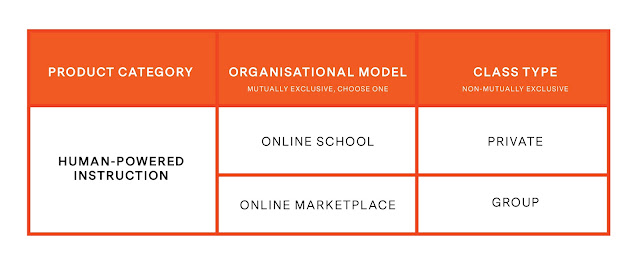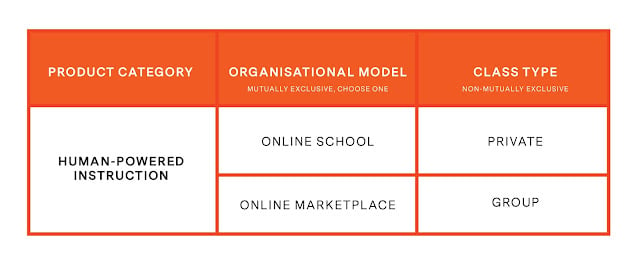Although teaching live online via a virtual classroom is not new, it has as of recently become essential to many who were previously unfamiliar with it or resistant to change. Why, you may ask? It starts with “C” and ends with “orona”.
In our last blog post, we tried to start making sense of the world of "LangTech".
As a refresher, LangTech refers to the companies, people and programs that create or use technology to support or enable language instruction.
We spoke about how the industry was divided into 3 main product categories: Human-Powered Instruction (a human being is the main decision-maker behind the instruction delivered to the learning), Machine-Powered Instruction (a machine or computer program is the main decision-maker behind the instruction delivered to the learner), and Mixed Instruction (a combination of the two). What a poignant sign of the times that we now have to differentiate human teachers and algorithm-based instruction!
In this follow-up post, we delve into more detail on the first category:
Human-Powered Instruction (HPI)
While there is some asynchronous online instruction with learners getting feedback on their written language skills, the vast majority of HPI is synchronous (real-time communication between the teacher and student through a virtual classroom or a standard video conferencing tool).
If you’re in a position to make product design choices about how your organisation helps students learn, and decide to move forward with a Human-Powered Instruction category, then there are two very important choices:
1. Model: School vs Marketplace
2. Class Type: Private, Group, Mix
Below we aim to describe the edges of these spectrums and hope that this will help you clarify your position in the market and identify what is important to your organisation and students.
Organisational Model: Online School vs Marketplace
Online School
An Online School is centrally managed and the organisation, rather than the teacher, is typically the one responsible for the delivery and quality of the class.
These responsibilities generally include providing curriculum, class guidelines and lesson plans, teacher training, and software. The organisation is ultimately accountable to their students for what goes on within the classroom “virtual walls.” From a management and organisational perspective, this model is the most similar to a brick-and-mortar language school. Usually the price is set by the school and the range appears to be between $13 and $40 per hour for private classes, and $5 and $12 per hour for individuals to join group classes.
Brian Kantt, the co-author of this blog post, actually runs one of the most successful online language schools in Europe, Iboux Education, so has a lot of practical knowledge on the pros and cons of choosing a school vs marketplace approach.
Benefits
- Students get plenty of support in achieving their learning goals not just from their teacher, but from the organization.
- This may materialise in the form of being paired with a study advisor, having a personal learning plan created for them, and the organisation continuously working with the student through the learning journey to continuously meet his/her needs.
- Teachers also typically get plenty of support from the organisation, which may materialise in the form of professional training and development, access to a Teacher Coordinator, etc.
- Curriculum (including class materials and methodology) are centralised and standardised, which ensures pedagogical continuity when students change or simultaneously take classes with several instructors.
- Students also generally get support from the organisation in administrative, logistical and technical matters, such as rescheduling, cancellations, etc. (since it’s the organisation, not the teacher, the one responsible for ensuring that the class takes place).
Trade-Offs
- Teacher variety and diversity may be limited because the school administrators typically screen teachers more thoroughly and may limit supply.
- Students are generally not able to access a wide range of price options.
- For example, they might be willing to pay less money to take classes with a less experienced teacher. The online school model typically implies school-wide rather than teacher-based rates.
Online Marketplace
An Online Marketplace is de-centrally managed and it is not the organisation, but each individual teacher, the one who is typically responsible for the delivery and quality of the class.
The main role of the marketplace is to connect students with independent instructors (who may or may not have been vetted) through their platform. Students can select the teacher that best matches their needs and price range, usually with a very wide range of teachers to choose from. Teachers are typically responsible for choosing and providing their own class materials, software or video conferencing communication tool (although in some cases the organisation may provide their own tool as an option), and set their own prices.
The most well-known language marketplaces are Italki (created in 2007), Preply (created in 2013) and Verbling (created in 2011, and acquired by Busuu in 2019). Tutors will often pay a fee to the host marketplace either for listing or for each class. Tutors charge whatever they like but a common range appears to be between $10 and $30 per hour.
Benefits
- Wide range of teachers, sometimes numbering the hundreds or over a thousand for a single language.
- Wide range of price options, since less experienced teachers or experienced teachers who live in areas with a lower cost of living might be willing to charge less for their time. You can therefore typically find options to fit most budgets.
- Teachers who are more independent have plenty of freedom and flexibility to choose their own materials, methodology, and overall course guidelines, and to set their own prices.
- They also have more flexibility with regard to deciding how many and which type of students to accept. Wide range of languages offered and easy onboarding process for new languages.
Tradeoffs
- Students who are not independent learners might find it difficult to navigate their learning journey without a clear course structure. Additionally, since methodology and curriculum aren’t centralized, they might need to go through a few tries with different teachers before they find one who is a good fit for them.
- Limited organization involvement means the student doesn’t get much support in the form of a solution when there is an issue. The most common example of this is when a class is cancelled by the instructor: since the class is ultimately provided by the teacher, the organization typically won’t find a solution to this cancellation (such as finding a substitute teacher) to guarantee that the class takes place at the time that was agreed upon.
Class Type
Once you have chosen which organisational model is a better fit for you and your students, you’ll need to decide whether to offer private classes, group classes, or both.
An online private class is where a teacher gives assistance, instruction or guidance to one individual learner.
An online group class is where a teacher gives assistance, instruction or guidance to more than one learner for a period of time.
Both are usually done in a virtual classroom, like LearnCube, or perhaps using a free video-conferencing tool like Zoom or Skype.
We typically describe a small group class including more than 1 person but less than 8 students, and a large group class of more than 8 students.
The size of the class makes a big difference, especially online. The content and experience and tech-savvy of the teacher, make a big difference on the effectiveness of the online class.
Large groups are where so many brick-and-mortar language schools are putting their energy because it is the model they, and the agents they rely on, are most familiar with. Transitioning schools (i.e. schools who are transitioning their programmes to an online setting, either fully or partially) are experiencing varied success with this.
EF, already one of the largest physical language school chains in the world, has been teaching online for many years under the brand EF English Live (formerly Englishtown) and considers a maximum class size of 17.
Lingoda is one of the leading providers of on-demand online small group classes, focused on Europe, and limits their classes to 5. The level of interaction a student has with a teacher will vary significantly depending on the class size which is why smaller groups often sell at a premium versus larger group classes.
Now that you have a better understanding of what the landscape of Human-Powered Instruction or HPI looks like, we'll next explore the second product category in the field of LangTech: Machine-Powered Instruction or MPI.
Unlike HPI, MPI doesn’t have an obvious parallel product in the analogue or offline world, which makes this category particularly exciting. Stay tuned for our next blog post on this topic!
Note: We have excluded peer learning from this category. One main reason for this is we see this category typically fitting under the scope of informal learning as peer-to-peer learning is generally not delivered in a systematic, planned and guided manner.


